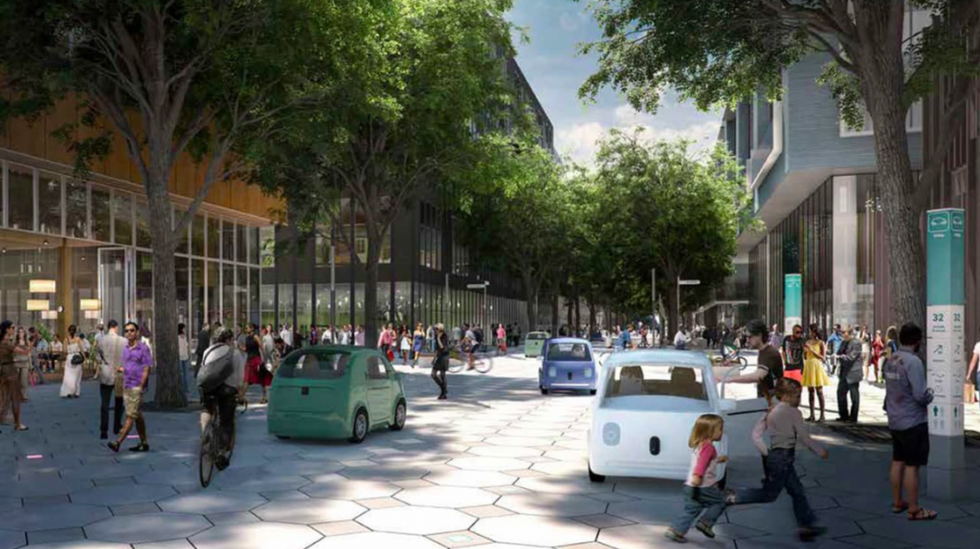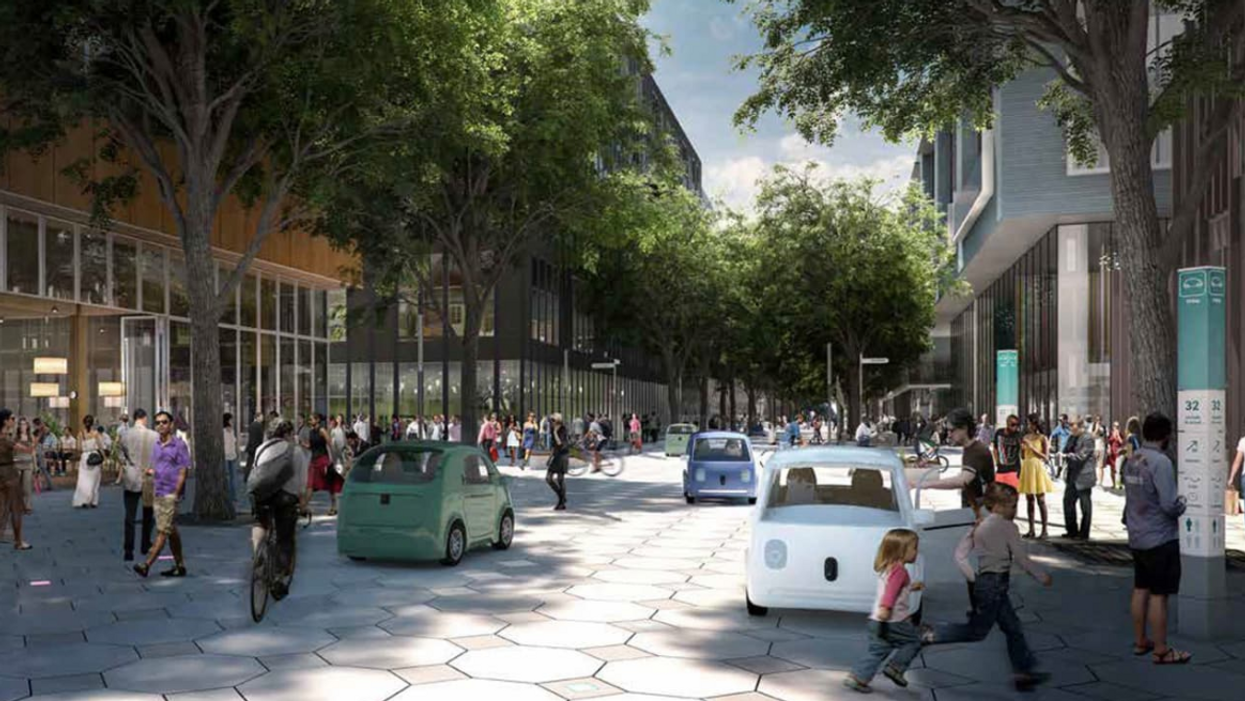
Down at Conspiracy-on-the-Lake, the plot to steal Toronto is slowly but surely taking shape.
Disguised as a mild-mannered community, based on new and innovative ideas about city building, the 12-acre experimental neighbourhood is really a nefarious attempt by big businesses to gobble up our fair burg.
Thank goodness the local media isn't fooled.
READ: Sidewalk Labs Reveals Latest Plans For ‘City Of The Future’ In Toronto
"Big questions still need to be answered," CBC Radio breathlessly reported last week.
In the same report, a Ryerson professor fretted because we don't know how Sidewalk Labs, the New York outfit that won the competition to design and build Quayside (known also as Conspiracy), will make money from the scheme.
In case you wondered, the prof's words reflected a concern about Sidewalk's modus operandi, not its bottom line.
Quayside's most enthusiastic critic, Bianca Wylie, co-founder of Tech Reset Canada, rails on cue about privacy and worries about who will own the data collected in a neighbourhood planned "from the internet up."
As she told the WorldPost recently, “The smart city industry is a Trojan horse for technology companies. They come in under the guise of environmentalism and improving quality of life, but they’re here for money.”
Wylie's response to two public presentations held earlier this month was titled, "Debrief on Sidewalk Toronto Public Meeting #3 — A Master Class in Gaslighting and Arrogance."
READ: When The Future Came To Toronto: Welcome To The Year 2037
In case you've just returned from another galaxy, what's got everyone huffing and puffing isn't Sidewalk Labs at all, but its sister company, Google.
Yes, that Google!
Few of us have any illusions about the tech behemoth. Good thing it's not involved in the revitalization of the now infamous site at the foot of Parliament St. and Lake Shore Blvd.
Google's real business, lest we forget, is advertising. That accounts for its insatiable hunger for data. The more personal the more valuable.
As anyone with a cellphone knows, Google already has a pretty good idea of where we shop, what we buy, where we are and what we do.

A project like Quayside could potentially give Google an unprecedented opportunity to track a community through its every waking hour and, presumably, every sleeping one, too. If Sidewalk were allowed to design and develop the rest of the 880-acre Port Lands, the argument goes, that could mean upwards of 10,000 residents would be under Google's microscope, or should we say, its sensors.
READ: Toronto Ranks As One The Most Future-Proof Cities On The Planet
But critics forget that neither Sidewalk Labs nor Google call the shots, Waterfront Toronto does.
Since its founding in 2001, Waterfront Toronto has done a superb job of redeveloping the 1,000 acres it controls, all the while answering to all three levels of government. For the most part, however, the fear mongers have limited knowledge of WT. They know little about its mandate, its history or its operations.
Their interest isn't urban innovation, city-building or for that matter privacy. What gets them going is technology. For them, technology is an end; for urbanists, it's a means.
And as Sidewalk Labs' head of urban systems, Rohit Aggarwala, points out, "Waterfront Toronto still has to approve our plan. We're still in an early stage of the planning process. It's got such a long way to go. We don't have all the answers. At this point, we shouldn't have all the answers."
Sidewalk's draft plan is due in January, 2019. It will get specific about details such as building heights, financing, uses, materials.
As Aggarwala makes clear, "Our mandate is to provide a plan for Quayside. If what we come up with is financially and practically feasible, we have the writ go proceed on a broader vision."
If that plan doesn't meet expectations, Waterfront Toronto will turn it down.
READ: Is The Multi-Million-Dollar Quayside Project Worth The Risk For Toronto?
If Sidewalk gets to go-ahead, the "broader vision" would mean the Port Lands. Even if that were to happen, it's years away. In the meantime, Sidewalk's efforts are focussed on what Quayside would look like, what it might include and how its limited space would be used.
At the public sessions held last week, designers talked about some of the ideas they are considering. One of the most interesting was timber towers. Standing as tall as 30 storeys, these buildings would be cheaper than conventional structures and more affordable and environmentally friendly.
Currently, wooden highrises such as these couldn't be built in Toronto. Regulations restrict them to six floors and, more to the point, the industrial capacity doesn't exist. But if enough wooden buildings were to be constructed, a factory becomes economical.
After that, the technology can be exported around the world.
Sidewalk is also studying the idea of using modular pavers for streets and sidewalks. This would allow repairs to be completed with relative ease. It could also mean ground-level lighting and heating. That, in turn, would eliminate the use of salt in winter.
Waterfront Toronto's chief development officer, Meg Davis, emphasizes the need to ensure that Quayside's streets are integrated into the public realm. Accordingly, Sidewalk is exploring the notion of making the ground floor of every building fully public.
It foresees "raincoats for buildings" that would extend — even double — their usability in bad weather, especially in winter.
Sidewalk staffers imagine buildings with moveable walls, covered pathways based on the ancient Greek concept of the stoa and "radical" mixed-use buildings. That might mean residential, retail, commercial and even light industry in one structure.
The insistence on flexibility, affordability, sustainability and design excellence will strain local zoning rules and regulations.
READ: 3 Toronto Suburbs You Won’t Recognize In The Future
It will be interesting to see how the city responds. Certainly, its planners will be uncomfortable dealing with such forward-looking ideas. But with an empty site such as Quayside, the opportunities are endless.
"Innovative systems are hard for governments,"Aggarwala admits.
"We'll have to get regulatory help from government. The process here is extremely robust. But some things have gotten lost in the story: one is that our ambition has never been to create a testing ground. We want to create a place where innovation is built into the structure of the community. We are not a real estate developer, but we do have planning expertise."
As for those privacy issues on which local media has fixated, Aggarwala says sensors will monitor air quality, traffic, security and the like, not track residents' comings and goings.
As he notes, the project will most likely pay off — if, in fact, it does — with products and techniques that evolve during the next few years. That could include pavers, timber construction equipment and building "raincoats" that could be applied elsewhere.
Also lost in the din is the fact that Quayside's success depends on factors beyond Sidewalk's control.
Among the most critical is the proposed LRT that would extend east along Queens Quay from Union Station. The tunnel between it and Queens Quay will have to be widened to accommodate the new line. Though promised more than a decade ago, the LRT's chances of getting built decrease with every passing year, leaving Quayside and the Port Lands high and dry.
Having Doug Ford in the premier's office makes things even worse.





















